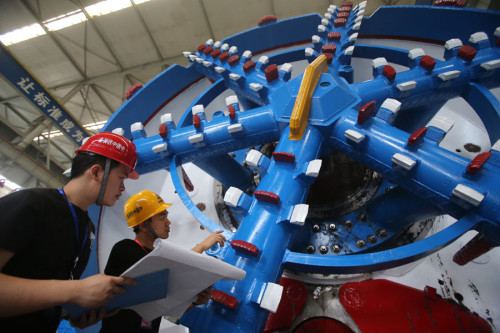
Two engineers from CRHIC check a railway tunnel-boring machine. (Photo provided to China Daily)
CRHIC of China Railway Group uses homegrown tech to connect key B&R regions
There is something common to the railway bridges across rivers like the Nidelva in Norway, the Donau in Germany and the Sava in Serbia. All these steel bridges, and another one in metropolitan New York, were built by China Railway Hi-Tech Industry Co Ltd.
The company has now identified other spots overseas to build railway bridges.
A subsidiary of State-owned China Railway Group Ltd, CRHIC signed two contracts in January to build a steel bridge each across the Rhine in Germany and the Slussen in Sweden. The two projects will be worth $32 million and $11.9 million respectively, and mark yet another breakthrough for CRHIC in the European market.
CRHIC has set up branches in Singapore and Germany over the past two years. It plans to open offices in Europe and Australia over the next three years, build sales networks, and team up with local dealers.
Besides, it would bid for more overseas projects, especially in countries and regions participating in the Belt and Road Initiative.
Proposed by China in 2013, the initiative aims to build trade, infrastructure and service networks connecting Asia with Europe and Africa based on ancient land and maritime trade routes.
"Many of these opportunities come from these markets' growing demand for upgraded and renewed infrastructure facilities, subway projects, water conservation and underground crossings," said Yi Tiejun, the group's chairman.
Since CRHIC made its international debut in Norway in 2007, it has grown in strength. In 2012, an order from the United States to refurbish the Verrazano-Narrows Bridge, the local landmark bridging Staten Island and Brooklyn, made CRHIC a global brand.
After over five decades in service, the bridge had worn out and needed fabricated steel to replace the upper deck. The bridge contract sparked a local debate on whether Chinese steel should be used, given concerns over quality.
However, former chairman of the Metropolitan Transportation Authority in New York State, Thomas Prendergast, said there was an "absence of domestic steel fabricators capable of satisfying the requirements for a project of this scope and complexity".
Carl Redmond, the senior project engineer, has shown confidence in Chinese steel. "We are absolutely convinced the quality is high."
So far, CRHIC was responsible for 15,000 metric tons of fabricated steel on the deck, which was expected to have a 75-year lifespan.
According to CRHIC, in the past decades, manufacturers from the US and Europe owned the vital technology for the manufacture of steel products used in building bridges. Such products offered better performance material, shorter project period and higher safety control.
But CRHIC had never given up the fight. The group has deployed a large number of resources and manpower in independent research and development between 2007 and 2017, to catch up with the global giants and elbow its way into the international market.
CRHIC has built over 24 steel bridges overseas in Southeast Asia, Northwest Africa, Southeast Africa, North America and Oceania.
Meanwhile, production of steel to be used in the construction of the Padma Bridge in Bangladesh is on. It is CRHIC's biggest overseas project. The bridge will play an important role in the Belt and Road Initiative, across the Padma River in Bangladesh, connecting the southwest of the country to the northern and eastern regions.
The company signed contracts worth 25.04 billion yuan ($3.97 billion) with clients from both domestic and overseas markets in 2017. Its profit was 1.27 billion yuan, thanks to its diversified product categories, expanded sales channels and go-global strategy.
"The company has seized the opportunities brought by the Belt and Road Initiative and is speeding up its overseas expansion," said Yu Zan, deputy general manager of the company. "The company has projects in over 22 countries and regions, and it has outstanding advantages in Southeast Asia and the Middle East.
"The steel beam products have also gained popularity in the US and Europe. Since the company went public, it has secured projects such as the one from the LaGuardia Airport in New York. It has sold 31 tunnel-boring machines in over 13 countries and regions including Malaysia, Singapore and Lebanon."
Yu, who also is the company's secretary to the board of directors, said since CRHIC completed its structural reform and got listed, the tunnel-boring machine business has seen a significant uptick. CRHIC has become the world's second-biggest seller of such machines. It also has the largest market share in this segment in Asia.
"CRHIC has developed its tunnel-boring machine technologies independently," Yu said. "It means the end of an era that saw the monopoly of foreign manufacturers."


















































